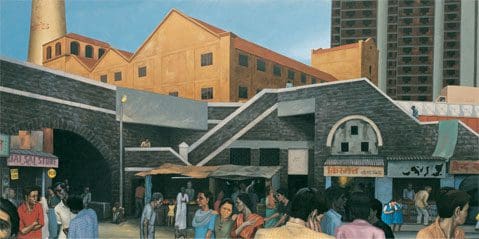
Introduction to the exhibition
Social Fabric focuses on the textile industry and its relation to capital, labour, colonialism, international trade and radical politics. The exhibition examines the social and economic role of textiles, particularly in India. Its starting point are works by artists Alice Creischer about the circulation of global commodities and by Sudhir Patwardhan who records the impact of the textile industry on Mumbai. Showing alongside are new artists’ commissions, films, books, fabrics, prints and audio recordings.
The exhibition refers to Karl Marx’s account of boom and bust in the industry and its effects on workers in Britain and India. The craze for Indian Chintz caused Spitalfields weavers to protest in 1719, and a century later the restrictions on imports devastated India’s textile industry.
Work in the exhibition
Artists in the exhibition: Alice Creischer, Celine Condorelli, Archana Hande, Sudhir Patwardhan, Raqs Media Collective, and Andreas Siekmann.
Alice Creischer’s installation Apparatus for the Osmotic Compensation of the Pressure of Wealth during the Contemplation of Poverty tracks the threads that connect cycles of investment, disinvestment, and decline. Inspired by a trip to India, the work looks at the economic and social impact of European colonialism and subsequent globalisation. The craze for Indian Chintz caused protest amongst Spitalfields weavers in 1719 and devastated whole sections of its textile industry. This led to Gandhi’s choice of the spinning wheel as a symbol of decolonisation, and caused Nehru to comment that – ‘the history of cotton and textiles is not only the history of growth of modern industry in India, but in a sense it might be considered the history of India.’
Since the mid-1970s, Sudhir Patwardhan has depicted Mumbai and its urban proletariat. His painting Lower Parel (2001) shows ‘Girangaon’ (mill village) the place where the cotton mills that transformed the city’s economy and led to the Indian industrial revolution were located. By the 1970s textiles employed one in three of the city’s workers and sucked in migrants from surrounding regions. New social institutions evolved with forms of cultural expression including street theatre, poetry and music and it was a hub for trade union activity and left politics. This painting depicts the area after the mills closed down in the early 80s, superimposing different urban strata – the defunct factories, new small scale enterprises and high rise luxury apartments, invoking the workers’ struggle to keep the mills going and resist gentrification.
These two complex works are examined through an extensive display of archival loans and artist interventions, including Company Paintings, Indian Chintz, original journals from Marx, films, photographs, newspaper articles and recordings of mill workers’ testimonies.
Screening Programme
Ashim Ahluwalia, Anjali Monteiro, K.P. Jayasankar, The Otolith Group, Madhusree Dutta, Tushar Joag and Anand Patwardhan.
Research
Meena Menon, Jyotindra Jain, Prasad Shetty and Rupali Gupte
Social Fabric will tour to Londs Konsthall from 6 April until 27 May.